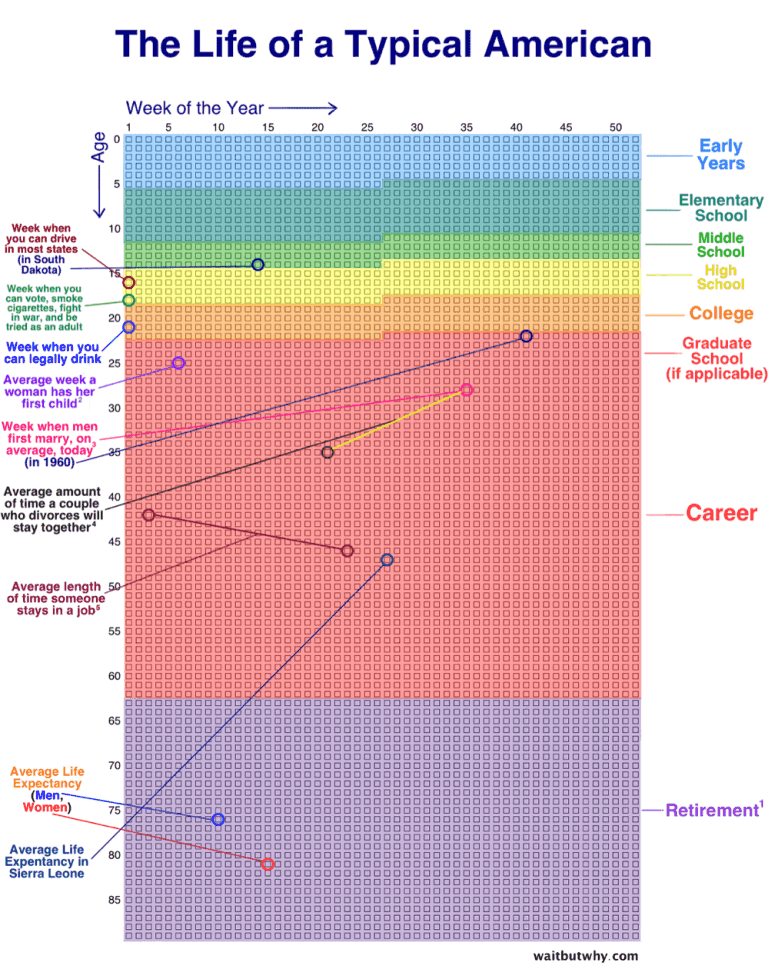Introduction
Imagine your entire life laid out week by week on a single page. Each square represents one week-some filled, many still blank. This is the essence of the "life calendar in weeks," a powerful visual tool that brings the abstract concept of time into sharp focus.
By visualizing our weeks, we can better appreciate the time we've spent and the time we have left, prompting us to make more intentional choices.
In this comprehensive guide, we'll explore the origins of the life calendar, its psychological impact, and practical ways to incorporate it into your daily life.
Table of Contents
- Understanding the Life Calendar
- The Psychology Behind Visualizing Time
- Creating Your Own Life Calendar
- Incorporating the Life Calendar into Daily Life
- Case Studies: Transformations Through Time Visualization
- Common Mistakes and How to Avoid Them
- Expert Insights on Time Management
- The Life Calendar and Stoic Philosophy
Understanding the Life Calendar
The concept of the life calendar gained popularity through Tim Urban's blog, Wait But Why, where he introduced a visual representation of a 90-year life span broken down into weeks.
This visualization consists of 4,680 squares, each symbolizing one week. By marking off the weeks that have passed, individuals can see how much time remains, fostering a sense of urgency and prompting reflection on how they spend their time.

This tool serves not only as a reminder of life's brevity but also as a motivator to live more intentionally. By confronting the finite nature of our existence, we are encouraged to prioritize meaningful activities and relationships.
The Psychology Behind Visualizing Time
Visual tools like the life calendar tap into our cognitive biases, making abstract concepts like time more tangible. By seeing time laid out visually, we can better grasp its passage and the importance of each moment. This aligns with the psychological principle of "temporal discounting" where immediate rewards are often valued over long-term benefits.
Short-Term Reward
Instant gratification, small wins
Long-Term Reward
Lasting achievement, big goals
The life calendar counters this by highlighting the limited nature of our time, encouraging long-term planning and goal setting.
Moreover, this visualization can reduce procrastination. When we see the weeks slipping away, we're more likely to take action on our goals and aspirations. It serves as a constant reminder to make the most of each week.
Creating Your Own Life Calendar
Crafting a personalized life calendar can be a transformative experience. Here's how to get started:
Determine Your Lifespan: Decide on the number of years you want to represent (commonly 90 years).
Calculate Total Weeks: Multiply the number of years by 52 to get the total number of weeks.
Design the Grid: Create a grid with rows representing years and columns representing weeks.
Mark Your Age: Fill in the squares corresponding to the weeks you've already lived.
Set Goals: Use different colors or symbols to mark future goals or significant events.
This exercise not only provides a visual representation of your life but also serves as a planning tool for future aspirations.
For better experience you can use our Life Calendar Application.
Incorporating the Life Calendar into Daily Life
Integrating the life calendar into your routine can enhance its effectiveness:
Morning Reflection: Start your day by reviewing your calendar, reminding yourself of your goals and the passage of time.
Weekly Updates: At the end of each week, fill in the corresponding square, reflecting on accomplishments and areas for improvement.
Goal Tracking: Use the calendar to mark milestones, deadlines, and significant events, keeping your objectives in clear view.
By making the life calendar a part of your daily life, you reinforce its message and stay aligned with your long-term goals.
Case Studies: Transformations Through Time Visualization
Many individuals have reported profound changes after adopting the life calendar:
Increased Productivity: By visualizing time, users have become more focused on meaningful tasks, reducing time spent on trivial activities.
Enhanced Goal Setting: The calendar serves as a constant reminder of personal goals, leading to more consistent progress.
Improved Life Satisfaction: Recognizing the finite nature of time has prompted individuals to prioritize relationships and experiences that bring joy and fulfillment.
These transformations highlight the life calendar's potential to positively impact various aspects of life.
Common Mistakes and How to Avoid Them
While the life calendar is a powerful tool, certain pitfalls can diminish its effectiveness:
Neglecting Regular Updates: Failing to consistently mark weeks can reduce the calendar's impact. Set reminders to update it weekly.
Overcomplicating the Design: Adding too many colors or symbols can make the calendar confusing. Keep it simple and clear.
Focusing Solely on the Past: While reflecting on past weeks is important, ensure you're also planning and looking forward to future goals.
By being mindful of these common mistakes, you can maximize the benefits of your life calendar.
Expert Insights on Time Management
Time management experts emphasize the importance of visual tools in enhancing productivity:
Oliver Burkeman, author of Four Thousand Weeks: Time Management for Mortals, discusses embracing the limitations of time to focus on what truly matters .
David Allen, creator of the Getting Things Done methodology, advocates for externalizing tasks and timelines to clear mental space.
These insights align with the principles behind the life calendar, reinforcing its value in effective time management.
The Life Calendar and Stoic Philosophy
The life calendar resonates with Stoic principles, particularly the concept of memento mori—remembering one's mortality. By acknowledging the finite nature of life, individuals are encouraged to live virtuously and focus on what they can control.
The average human lifespan in weeks
3809
Weeks
This philosophical alignment adds depth to the practice of using a life calendar, connecting daily actions to broader existential reflections.